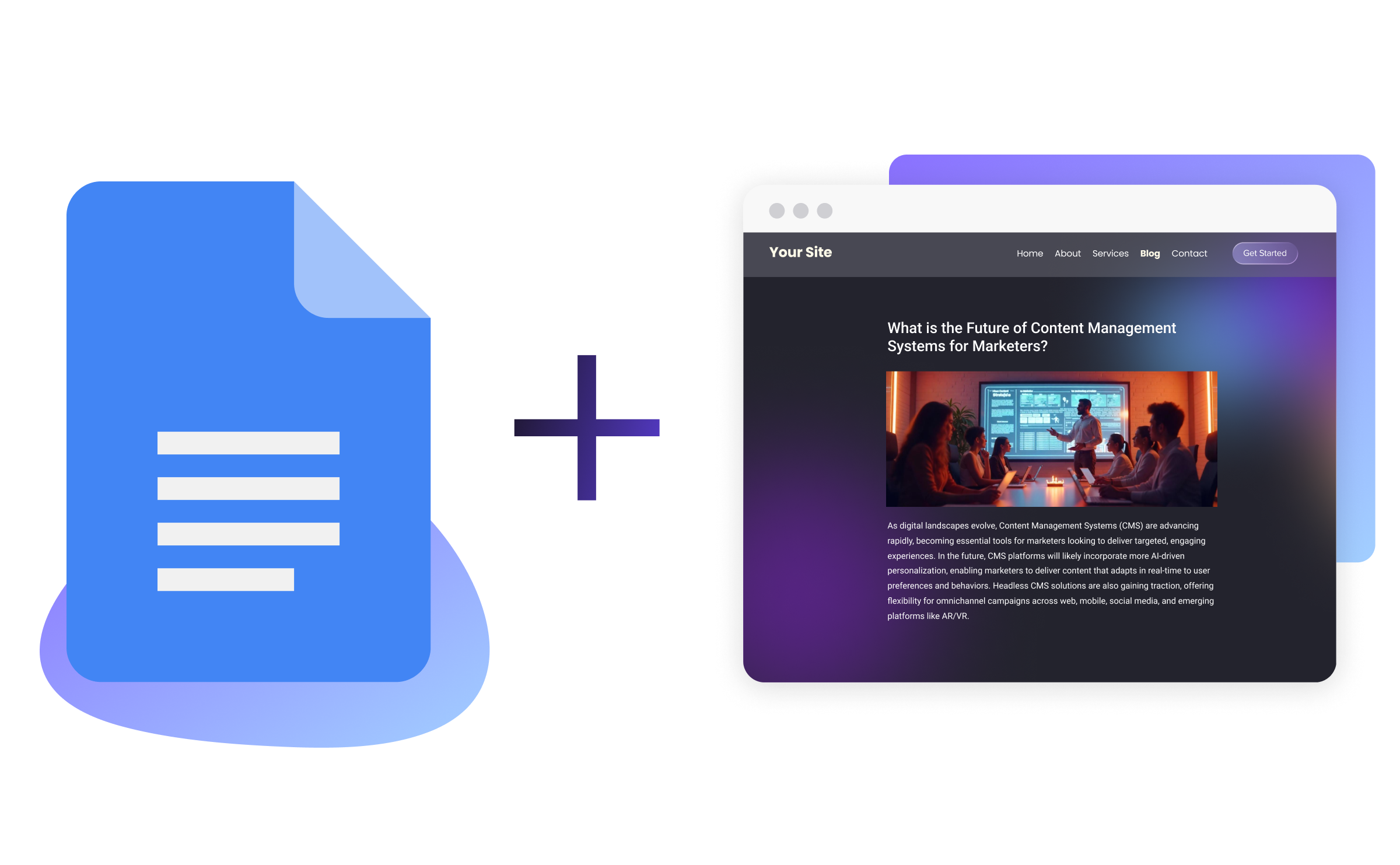Safely Publish to Web from Google Docs with Pantheon Content Publisher
Image

At Pantheon, for years, we have increasingly felt that website publishing is fundamentally broken. A few years ago, we started sketching out a vision for how to fix it. Last year, we started designing a new product and writing code. Now, we are ready to preview our first innovation in a new vision for website technology and explain what we are building next and why.
Today, we are announcing Pantheon Content Publisher for Google Docs, a rethink of how you write, edit, collaborate, and publish to the web. Our goal with this first feature is to make it radically simpler for writers to create and publish web content directly from Google Docs to WordPress, Drupal, and Next.js websites—safely and seamlessly.
With Content Publisher, as you type and edit in Google Docs, you can see a live preview of how content will render on your website. When you’re ready, simply click a button in Google Docs for editorial review and publishing.
This feature is part of a much bigger vision for where we plan to take the website technology industry. The web used to be simple and fun. It’s increasingly becoming tedious, flaky, and frustrating. We built Content Publisher to change that.
How is web publishing broken?
Who gets up in the morning, grabs their coffee, sits at their desk, and writes web content directly in WordPress or Drupal? Almost nobody. In our research, 90% of writers create, edit, and collaborate on content in Google Docs and Microsoft Word.
This makes sense. Docs and Word are incredibly good software—especially for collaborative review and editing—and their pace of innovation is only increasing with AI. Because of this, writing, editing, and collaborating on website content has shifted to the domain of Google Docs and Word over the past decade.
But how do you get content written and revised in Docs and Word into your CMS and then published on your website?
Good question! Docs and Word today do not connect with CMS tools like WordPress and Drupal.
Brandfolder Image

This means website teams today must literally copy and paste content into WordPress and Drupal. It’s 2024, but somehow, the website technology industry is stuck in 1999.
It’s worse than that. Given the complexity of CMS tools, it’s more likely that the person who authored the content hands it off to the “website person,” who then copies and pastes it into WordPress or Drupal. The “website person” then has to ensure the formatting is optimized for the web, with images rendering correctly, the post being mobile-friendly, and the content meeting accessibility and brand guidelines. In reality, however, many of these checks get skipped, and publishers just hope for the best.
Consider what this means— the authoring and editing workflow in Docs and Word is completely disconnected from the publishing workflow in WordPress and Drupal. This disconnect in the tools has created a fundamental breakdown in website publishing.
How teams publish content to their websites today
After the copy and paste process, the website team ensures the content is safe for the web; then what happens? A lot of frustration.
Brandfolder Image

When is your post going to go live? Only those with the CMS keys control that.
What happens if you find a typo after your post goes live on the website? You probably have to email the website person, “Hey, do you mind changing this line for me?”
How is your content performing? You probably won't find out unless you log into the marketing software stack.
How many people who write for the web can publish to the web? Increasingly, only those trained in how to use increasingly complex Content Management Systems can publish on their websites. The sad reality is that website publishing tools have become the domain of website experts. So much for “democratizing the web.”
How do you ensure formatting, accessibility, and content governance happen during content creation? If this only happens at the website publishing stage, you will be surprised by a lot of clean-up work right when you are at the deadline to publish.
The shortcomings in the website technology leave everyone out of sync and frustrated. For a website team, it leads to endless feedback loops, conflicting versions, and missed deadlines. Content changes become so painful that iteration actually slows down. If your marketing team's iteration speed slows down, your company growth rate will slow down too.
If you or your website team suffers from these problems, read on to learn more about what Content Publisher does, how it works, which sites and use cases it fits today, and how it will evolve in the coming months.
What Content Publisher does today
Content Publisher streamlines the publishing workflow from Google Docs to your website. Once you enable the Pantheon Content Publisher add-on in your Google Workspace, you can connect Google Docs with your website running on Drupal, WordPress, or Next.js. Content Publisher has three core capabilities for frictionless publishing.
Direct Publishing from Google Docs
The Content Publisher add-on appears as a sidebar as you edit content in Google Docs.
Brandfolder Image

It lets writers and editors enrich content with metadata, images, fields, and files. This means they can create complete, structured website content without leaving Google Docs.
Real-time preview at your fingertips
You can’t create rich website content in a vacuum. You need to see how everything will render on the actual website as you write, edit, and collaborate. Content Publisher provides a real-time preview.
Brandfolder Image

As you type in the Google Doc, drop in images, or configure structured components, you will see them appear fully rendered on the website preview. You can toggle between screen widths and click around.
An easy-to-use, trusted editorial publishing workflow
You are probably thinking, “If everyone who writes in Google Docs can publish to my website, isn’t that a risk?” No. This is why we built a robust – yet easy-to-use – editorial workflow. Governance, content checks, brand compliance, and accessibility are modern requirements for website publishing. We’ve designed Content Publisher to make this seamless and easy, built right into the software.
This starts by normalizing and sanitizing content, removing styles unoptimized for the web, and flagging content that doesn’t meet compliance or accessibility standards.
We have built a pluggable content review process that will be expanded to brand, accessibility, and compliance checks. We are engaging some of the most demanding editorial teams in the world in product design to make these features bulletproof.
Built-in generative AI features
Content Publisher includes AI powered by Google Vertex to assist writers and editors with content summaries, metadata suggestions to enhance SEO, and enhanced search. You control how these generative AI features in Content Publisher align with your brand.
Structure your content collections
Well-structured content is key to discoverability and usability by visitors to your site. We’ve built intuitive tools into Content Publisher to enable you to create and organize content collections. Collections in Content Publisher allow you to organize your documents into sections and sub-sections, order them, and choose how to hide or reveal them on your site.
The structures can then drive website navigation and discoverability. Your website can use as many content collections as required.
At the document level, Content Publisher lets you define custom metadata schemas for your documents beyond the standard title, descriptions, tags, and image fields. This can power your site's information architecture and pull in metadata from remote sources.
How Content Publisher’s core technology works
Content Publisher was developed with a modern, API-first approach to integrate with composable architecture website technology. Under the hood, Content Publisher is comprised of:
- An add-on for Google Docs that provides editors with a user interface within Google Docs.
- A modern, scalable service operating on the Google Cloud Platform that handles publishing and content discovery. It exposes these to the authoring and delivery environments through REST and GraphQL APIs.
- Out-of-the-box integrations with the leading website technologies: WordPress, Drupal, and Next.js.
Brandfolder Image

Our design goal with this architecture is to make it easy to integrate Content Publisher with a broad ecosystem of website and marketing technologies.
What it doesn’t do
Importantly, we don’t see Content Publisher as a CMS. Content Publisher imagines a world of post-CMS website technology. We think of it as a content integration service that integrates with your existing CMS today: WordPress, Drupal, or Next.js. This means that many website requirements will still need to be handled in your existing CMS: implementation of design and styles, navigation, caching, tracking, etc.
Content Publisher is not for every website: some content types are a good fit (articles, blogs, long-form content, documentation, etc.), while others are not so much (landing pages, complex layouts, transactional content, etc.). We recommend trying it out for single pages like your About page. Once you get the hang of it, expand to the sections of your websites where more editorial work happens, such as blogs and press releases. Content Publisher is not intended to power your whole website; it’s designed to be a great companion to full Content Management Systems such as WordPress or Drupal.
How to get started
Content Publisher is now available to use! Sign up here for the freemium version or review our other plans.
*Google Docs is a trademark of Google, LLC.


